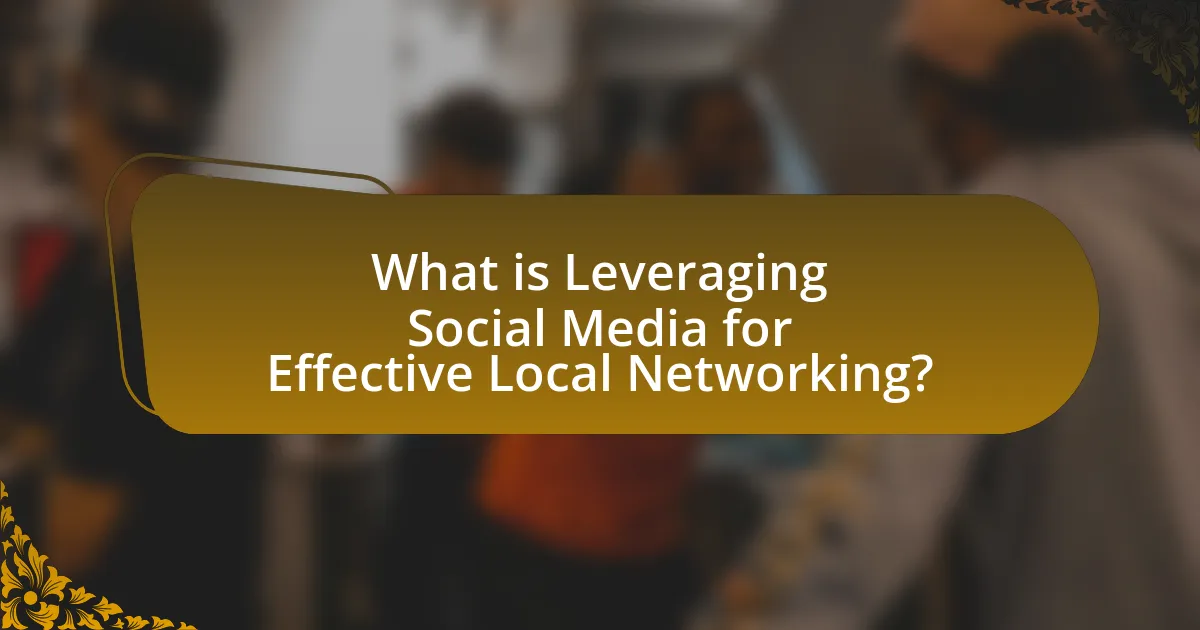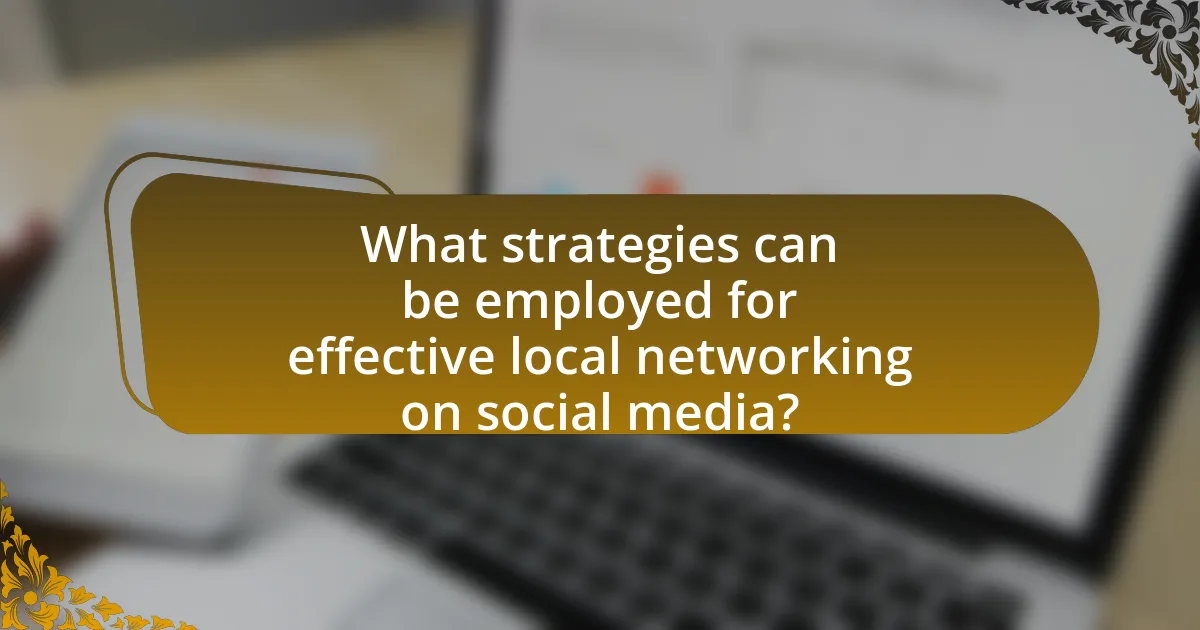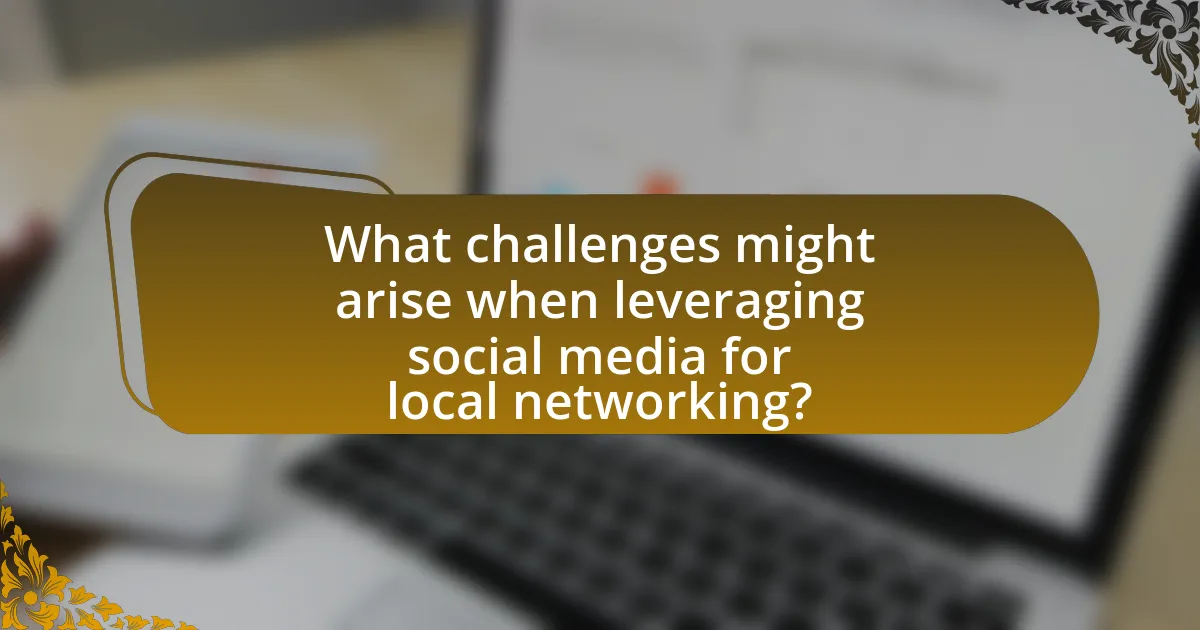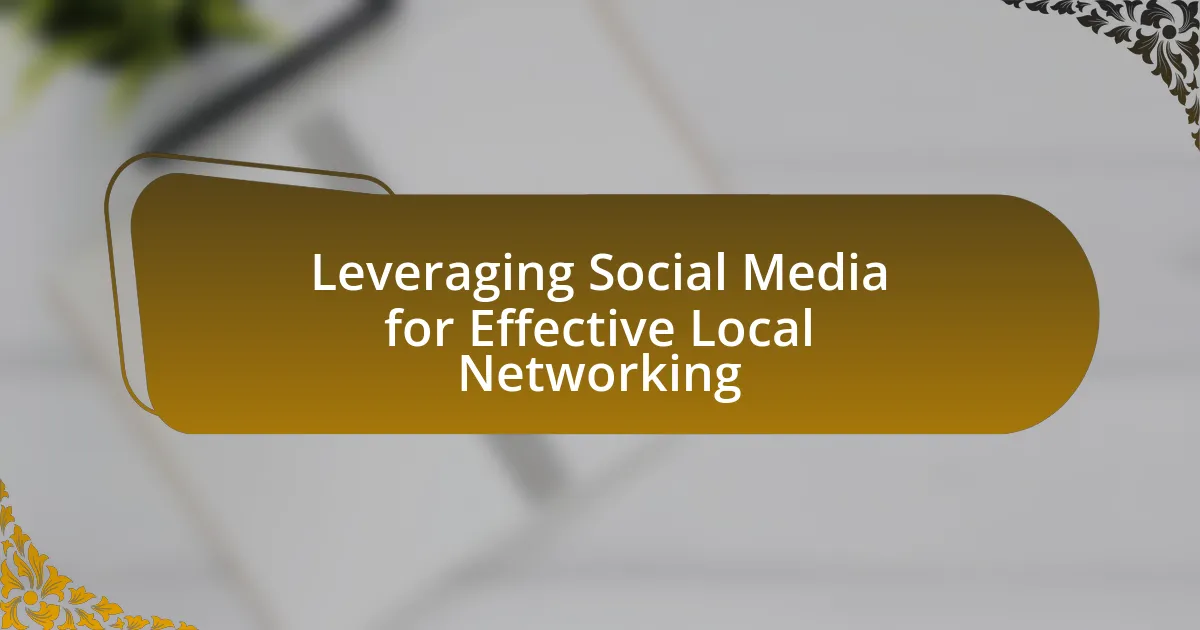Leveraging social media for effective local networking involves utilizing platforms such as Facebook, LinkedIn, and Instagram to connect with individuals and businesses within a specific geographic area. This article explores how social media enhances local networking opportunities, identifies the most effective platforms, and discusses the influence of demographics on networking strategies. It highlights the importance of local networking in fostering community engagement and trust, outlines key benefits, and provides strategies for effective engagement, audience analysis, and content sharing. Additionally, it addresses challenges in social media networking and offers best practices for maintaining relationships and enhancing local connections.

What is Leveraging Social Media for Effective Local Networking?
Leveraging social media for effective local networking involves using platforms like Facebook, LinkedIn, and Instagram to connect with individuals and businesses within a specific geographic area. This strategy enables users to build relationships, share resources, and promote local events or services. For instance, a study by the Pew Research Center indicates that 69% of adults in the U.S. use social media, making it a powerful tool for reaching local audiences. By engaging with community groups, participating in discussions, and sharing relevant content, individuals can enhance their visibility and foster meaningful connections that can lead to business opportunities or collaborations.
How can social media enhance local networking opportunities?
Social media enhances local networking opportunities by facilitating connections among individuals and businesses within a specific geographic area. Platforms like Facebook, LinkedIn, and Instagram allow users to join local groups, participate in community events, and share resources, which fosters collaboration and relationship-building. According to a study by the Pew Research Center, 70% of adults in the U.S. use social media, making it a powerful tool for reaching a broad audience and engaging with local communities. This high level of engagement enables users to discover local events, network with professionals, and promote their services, ultimately strengthening community ties and enhancing local business visibility.
What platforms are most effective for local networking?
The most effective platforms for local networking are Facebook, LinkedIn, and Meetup. Facebook allows users to join local groups and events, facilitating community engagement and networking opportunities. LinkedIn is tailored for professional connections, enabling users to network with local professionals and businesses. Meetup focuses on bringing people together around shared interests, making it ideal for local networking events. According to a 2021 survey by the Pew Research Center, 69% of adults in the U.S. use Facebook, highlighting its widespread reach for local networking.
How do demographics influence social media networking strategies?
Demographics significantly influence social media networking strategies by determining the target audience’s preferences, behaviors, and platform usage. For instance, younger demographics, such as millennials and Gen Z, tend to favor platforms like TikTok and Instagram, which prioritize visual content and short-form videos, while older demographics may prefer Facebook or LinkedIn for more professional networking. Research indicates that 71% of millennials use Instagram, compared to only 23% of baby boomers, highlighting the necessity for tailored content strategies that resonate with specific age groups. Additionally, factors such as gender, income, and education level further shape content types and engagement methods, as different demographic segments exhibit varying levels of responsiveness to marketing messages. Thus, understanding these demographic nuances allows businesses to craft more effective and targeted social media strategies that enhance local networking efforts.
Why is local networking important in today’s digital age?
Local networking is crucial in today’s digital age because it fosters community engagement and builds trust among individuals and businesses. In a landscape dominated by online interactions, local networking allows for personal connections that enhance collaboration and support within communities. According to a study by the Pew Research Center, 70% of adults believe that local connections are essential for personal and professional growth, highlighting the significance of face-to-face interactions in an increasingly digital world. This blend of online and offline networking creates opportunities for partnerships, referrals, and local business support, ultimately driving economic growth and community resilience.
What are the key benefits of local networking through social media?
Local networking through social media offers several key benefits, including enhanced community engagement, increased visibility for local businesses, and the ability to foster meaningful connections. Enhanced community engagement occurs as social media platforms facilitate real-time communication and interaction among local residents, allowing them to share events, news, and resources. Increased visibility for local businesses is achieved through targeted advertising and organic reach, which can lead to higher foot traffic and sales; for instance, studies show that 78% of consumers are influenced by social media posts when making purchasing decisions. Additionally, the ability to foster meaningful connections is evident as individuals can easily connect with like-minded locals, leading to collaborations and support networks that strengthen the community.
How does local networking impact community engagement?
Local networking significantly enhances community engagement by fostering relationships and facilitating communication among residents. When individuals connect through local networks, they share resources, information, and support, which leads to increased participation in community activities. Research indicates that communities with strong local networks experience higher levels of civic involvement; for instance, a study by the National Civic League found that neighborhoods with active social networks saw a 30% increase in volunteerism and event attendance. This demonstrates that local networking not only builds trust but also mobilizes community members towards collective action, ultimately strengthening the social fabric of the community.

What strategies can be employed for effective local networking on social media?
Effective local networking on social media can be achieved through targeted engagement, community involvement, and strategic content sharing. Engaging with local groups and pages allows individuals to connect with like-minded people and businesses in their area, fostering relationships that can lead to collaboration and support. Community involvement, such as participating in local events or initiatives, enhances visibility and credibility within the local network. Additionally, sharing relevant content that resonates with the local audience, including local news, events, and promotions, can attract attention and encourage interaction. According to a study by the Pew Research Center, 70% of adults use social media to connect with others, highlighting the platform’s potential for building local networks.
How can individuals identify their target audience on social media?
Individuals can identify their target audience on social media by analyzing demographic data, engagement metrics, and user behavior. Social media platforms provide analytics tools that reveal information such as age, gender, location, and interests of followers, allowing individuals to tailor their content accordingly. For instance, Facebook Insights and Instagram Analytics offer detailed reports on audience demographics and engagement rates, which can guide content strategy. Additionally, conducting surveys or polls can directly gather insights from the audience, further refining the understanding of their preferences and needs.
What tools can assist in audience analysis for local networking?
Tools that can assist in audience analysis for local networking include social media analytics platforms, customer relationship management (CRM) systems, and survey tools. Social media analytics platforms like Hootsuite and Sprout Social provide insights into audience demographics, engagement metrics, and content performance, enabling users to tailor their networking strategies effectively. CRM systems such as Salesforce and HubSpot help track interactions and preferences of local contacts, facilitating personalized communication. Additionally, survey tools like SurveyMonkey and Google Forms allow for direct feedback from the audience, providing valuable data on local interests and needs. These tools collectively enhance understanding of the local audience, leading to more effective networking outcomes.
How can user-generated content enhance local networking efforts?
User-generated content enhances local networking efforts by fostering community engagement and building trust among local participants. When individuals share their experiences, reviews, and recommendations on social media platforms, it creates authentic connections that encourage others to participate in local events and initiatives. According to a study by Nielsen, 92% of consumers trust recommendations from individuals over brands, highlighting the effectiveness of user-generated content in influencing local networking. This trust leads to increased participation in community activities, as people are more likely to engage with events and organizations that have positive endorsements from their peers.
What types of content are most effective for local networking?
Visual content, such as images and videos, is most effective for local networking. This type of content captures attention quickly and encourages engagement, which is crucial for building local connections. According to a study by HubSpot, posts with images receive 94% more views than those without, highlighting the importance of visual elements in attracting local audiences. Additionally, user-generated content, such as testimonials and reviews from local customers, fosters trust and credibility, making it a powerful tool for networking within the community.
How can storytelling be utilized in local networking efforts?
Storytelling can be utilized in local networking efforts by creating relatable narratives that foster connections among community members. By sharing personal experiences or local success stories, individuals can engage their audience emotionally, making interactions more memorable and impactful. Research indicates that stories can increase information retention by up to 65%, enhancing the effectiveness of networking initiatives. Additionally, storytelling can highlight shared values and common goals, which are essential for building trust and collaboration within local networks.
What role do visuals play in engaging local audiences?
Visuals play a crucial role in engaging local audiences by enhancing communication and fostering emotional connections. Research indicates that content with relevant images receives 94% more views than text-only content, demonstrating the effectiveness of visuals in capturing attention. Additionally, visuals can convey complex messages quickly, making them particularly effective in local marketing where immediate understanding is essential. For instance, local businesses that utilize images of their products or services in social media posts often see higher engagement rates, as these visuals resonate more with the community’s preferences and cultural context.

What challenges might arise when leveraging social media for local networking?
Challenges that may arise when leveraging social media for local networking include issues of trust, information overload, and the potential for miscommunication. Trust can be compromised due to the prevalence of misinformation and the difficulty in verifying the authenticity of profiles, which can hinder relationship-building. Information overload occurs when users are bombarded with excessive content, making it challenging to identify relevant local connections and opportunities. Miscommunication can arise from the lack of non-verbal cues in online interactions, leading to misunderstandings and conflicts. These challenges can significantly impact the effectiveness of local networking efforts on social media platforms.
How can individuals overcome common obstacles in local networking?
Individuals can overcome common obstacles in local networking by actively utilizing social media platforms to connect with others in their community. Social media enables individuals to identify local events, engage with community groups, and establish connections with like-minded professionals. For instance, a study by the Pew Research Center found that 69% of adults in the U.S. use social media, which highlights its potential as a tool for networking. By participating in online discussions and sharing relevant content, individuals can build their visibility and credibility, making it easier to network effectively in person.
What strategies can mitigate negative interactions on social media?
To mitigate negative interactions on social media, implementing clear community guidelines is essential. These guidelines establish acceptable behavior and set expectations for user interactions, which can reduce conflicts. Research indicates that platforms with well-defined rules experience fewer instances of harassment and bullying, as users are more aware of the consequences of their actions. Additionally, promoting positive content and encouraging constructive discussions can foster a supportive environment, further decreasing negativity. Studies show that communities focused on positivity tend to have higher engagement rates and lower instances of conflict, reinforcing the effectiveness of these strategies.
How can privacy concerns be addressed while networking locally?
Privacy concerns can be addressed while networking locally by implementing strict privacy settings on social media platforms and being selective about the information shared. Users should regularly review and adjust their privacy settings to limit visibility to only trusted contacts, ensuring that personal data is not publicly accessible. Additionally, individuals can utilize private groups or events for networking, which restricts access to a smaller, controlled audience. Research indicates that 70% of users are more comfortable sharing information in private settings, highlighting the effectiveness of this approach in mitigating privacy risks.
What are the best practices for maintaining relationships through social media?
The best practices for maintaining relationships through social media include consistent engagement, personalized communication, and sharing valuable content. Consistent engagement involves regularly interacting with connections through comments, likes, and shares, which fosters a sense of community and keeps relationships active. Personalized communication, such as sending direct messages or acknowledging milestones, strengthens bonds and shows genuine interest. Sharing valuable content, including insights, resources, or relevant news, positions individuals as thought leaders and encourages reciprocal sharing, enhancing relationship depth. Research indicates that active engagement on social media can lead to a 50% increase in relationship satisfaction, highlighting the effectiveness of these practices.
How often should individuals engage with their local network online?
Individuals should engage with their local network online at least once a week. Regular interaction fosters relationships, keeps individuals informed about local events, and enhances community ties. Research indicates that consistent engagement, such as sharing updates or participating in discussions, can significantly improve networking outcomes, as highlighted in a study by the Pew Research Center, which found that 70% of users who engage weekly report stronger connections within their communities.
What follow-up strategies can strengthen local connections?
Follow-up strategies that can strengthen local connections include personalized communication, consistent engagement, and community involvement. Personalized communication, such as sending tailored messages or thank-you notes after meetings, fosters a sense of appreciation and strengthens relationships. Consistent engagement through regular updates on social media platforms keeps connections active and encourages ongoing dialogue. Community involvement, such as participating in local events or supporting local causes, enhances visibility and builds trust within the community. Research indicates that maintaining regular contact and showing genuine interest in local affairs significantly increases the likelihood of forming lasting connections.
What practical tips can enhance local networking through social media?
To enhance local networking through social media, individuals should actively engage with local community groups and events on platforms like Facebook and LinkedIn. By joining these groups, users can connect with local professionals, share insights, and participate in discussions relevant to their area. Research indicates that 70% of professionals find networking through social media effective for building relationships (LinkedIn, 2021). Additionally, posting about local events or initiatives can increase visibility and attract like-minded individuals, fostering a sense of community. Engaging with local businesses by sharing their content or collaborating on projects can also strengthen connections and expand one’s network.
